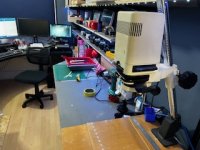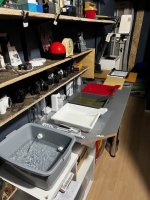- Messages
- 67
- Name
- Matt
- Edit My Images
- Yes
Hi,
Since getting back into analogue 35mm photography during the lockdown, I have been developing C41 & B&W at home with some successes and scanning the negs with a V500 Epson.
A few months ago I was gifted an Axomat 4 B&W enlarger (without the filters?) and Santa bought me trays, chemicals, microfocus etc.
Included was a pack of Ilford Multigrade RC Dulux ... my question is how do I work out the exposure times and do I need the filters that did not arrive with my old style enlarger?
There is a purple filter gel in the carrier and I have managed to set up the size and focus on a negative.
My darkroom is light-sealed (thanks to some channels I designed and 3D printed for the blackout blind and some black tape on the power lights of various devices.
Thanks In Advance
Matt
Since getting back into analogue 35mm photography during the lockdown, I have been developing C41 & B&W at home with some successes and scanning the negs with a V500 Epson.
A few months ago I was gifted an Axomat 4 B&W enlarger (without the filters?) and Santa bought me trays, chemicals, microfocus etc.
Included was a pack of Ilford Multigrade RC Dulux ... my question is how do I work out the exposure times and do I need the filters that did not arrive with my old style enlarger?
There is a purple filter gel in the carrier and I have managed to set up the size and focus on a negative.
My darkroom is light-sealed (thanks to some channels I designed and 3D printed for the blackout blind and some black tape on the power lights of various devices.
Thanks In Advance
Matt



